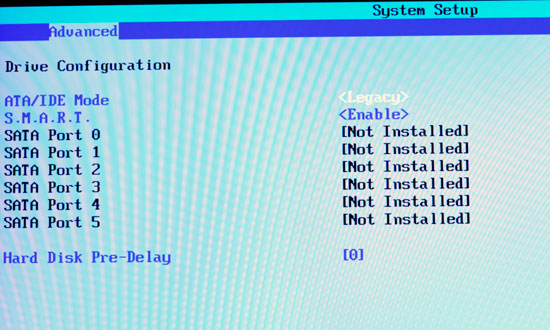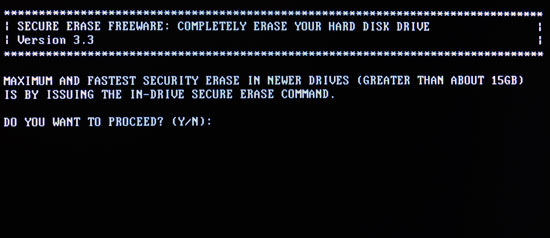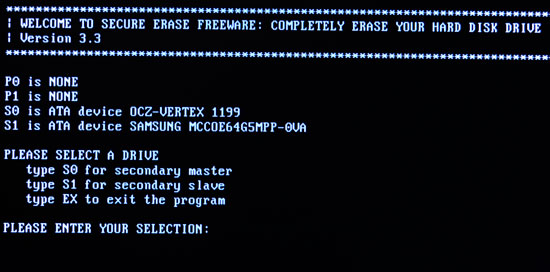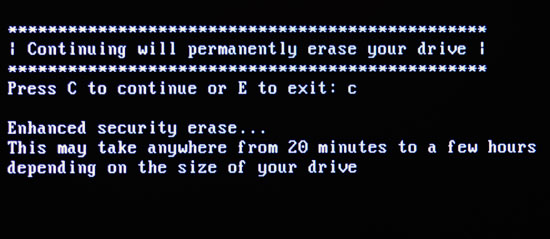The SSD Anthology: Understanding SSDs and New Drives from OCZ
by Anand Lal Shimpi on March 18, 2009 12:00 AM EST- Posted in
- Storage
Restoring Your Drive to Peak Performance
Based on my explanation there’s one sure-fire way to make your drive fast again. Formatting/deleting everything on the drive won’t work because those pages on the drive will remain full of data.
If you are doing a clean setup of your machine and want to restore your drive to its native state you’ll have to perform a secure erase. Intel distributed a tool with the first X25-M review kits called HDD ERASE. This tool will take any SSD and free every last page on the drive. Obviously you’ll lose all of your data but your drive will be super fast again!
In order for HDDERASE to work you need to have your SATA controller running in Legacy IDE mode, you can select this in your BIOS. Your drive will have to be connected to one of the first four SATA ports off of the controller.

Boot to a command prompt (I just use a bootable DOS image on my USB stick) and run the executable. Answer its questions carefully and with honor.



Tell it you would like to perform a secure erase (an extended one isn’t necessary) and when it asks you if you wish to view LBA 0 you can say no. Reboot your machine (don’t forget to set your SATA controller back to whatever mode you had it in before, e.g. RAID or AHCI), partition your drive and you’re back in business.
On a good SSD I don’t believe there’s a need to secure erase periodically, but whenever you format or re-image your drive, I’d recommend a secure erase since you’re killing all of your data anyway.










250 Comments
View All Comments
coil222 - Wednesday, March 18, 2009 - link
Yes I run a pair of MTRON 7500s in a raid 0 stripe for my OS and Gaming (wow). I don't recall numbers off the top of my head but tests were better on the raid 0 than a single drive configuration.Watch this:
http://www.youtube.com/watch?v=96dWOEa4Djs&fea...">http://www.youtube.com/watch?v=96dWOEa4Djs&fea...
sawyeriii - Wednesday, March 18, 2009 - link
I just wanted to state how much I loved the combination of technical and real world information in this article.What is the possibility of having different page sizes built into a drive? I.e. you could have a drive with many 1k page packages on one die, 2k on another, and most others 4k. Could that theoretically help? Could the controllers work with that (or would you need to combine multiple 1k's into a 4k transfer size)?
PS One note on page 3, the VelociRaptor and Intel in the first chart (responce time) are switched, however the text is correct.
StormyParis - Wednesday, March 18, 2009 - link
the ugly truth is that an SSD won't let you do anything that you couldn't do without it, and due to its cost and small capacity, it's not a replacement drive, it's an extra drive: not less power consumption but more, not less noise but just the same. You just gain a bit of time when booting up and lauching apps... which I do about 1/week and 1/day, respectively. Assuming your system has enough RAM (and if it doesn't, buy RAM before buying an SSD !), you won't feel much difference once the apps are launched.For the same cost, I'd rather buy a bigger screen.
It's urgent to wait for prices to come down. But I'm all for lots of people buying them now and help get the price down for us wiser buyers.
Rasterman - Thursday, March 19, 2009 - link
I've already decided my next system in a few months will have one, after you go through 5 hard drive failures (over several years) lets see how much your willing to pay to not have to put up with it anymore. If you use your PC for anything useful (work) then an SSD is a no brainer even at $1000/64GB IMO if the data security is there, speed is secondary for me.When you already have the best screen, video card, memory, why not have the best drive? And your argument is pretty dumb, almost any upgrade won't let you do anything that you couldn't do without it, not just SSDs.
Calin - Wednesday, March 18, 2009 - link
You get lower power due to the lower power use of the SSD and the fact that the other drive is not stressed with difficult access patterns (small random reads/writes). Remember that idle power of a SSD drive is very low7Enigma - Wednesday, March 18, 2009 - link
No, his comment was accurate for most users. Due to the small capacities and high cost these will be used as boot drives primarily with maybe a single heavily used program (say the current game or program you are playing/using), the rest will be on an additional drive. So while the power consumption of the SSD would be less than the old drive, the aggregate power usage of both (even when the larger storage drive is primarily at idle) will be higher than the single HD.And I believe you meant to say traditional HD for idle power?
strikeback03 - Wednesday, March 18, 2009 - link
If all you were going to throw on the drive is the OS and a game, a 32GB drive should be plenty. The reason the 80GB and up range is important is so general consumers can load all their programs on it.But yes, in consumer usage other than a laptop, some people who were previously using one drive for both boot and storage would likely need a mechanical HDD is addition to the SSD. OTOH, those who were using a Velociraptor (or RAID array) for boot and another drive for storage will see their power consumption decrease.
sawyeriii - Wednesday, March 18, 2009 - link
Have you used a SSD? (If so which)I would state that it is not a luxary product, it is a premium product. The price difference you pay WILL translate to faster performance (if you choose correctly). More RAM only helps upto a point.
Remember performance is based on a system of parts...
CPU
RAM
NORTHBRIDGE
GPU
SOUTHBRIDGE
I/O INTERFACE
HDD/SDD
Microsoft's Windows Experience Index has specific flaws, but the concept is sound... The system can only go a fast as the slowest component in the system (relative to the amount of time used by that component).
Testtest - Wednesday, March 18, 2009 - link
... there's also Supertalent's Ultradrive ME (MLC) and LE (SLC) and Photofast's G-Monster v3At least the Supertalent drives are quite a bit cheaper with the same drive layout/controller than the Vertex drives and only differ in the firmware (which isn't bad either).
It's however possible at least with the Ultradrive ME currently to provoke a kinda timeout error after they've been fully filled once and then still beeing written on. I don't own a Vertex so I can't test that there but if it was a controller issue, it should pop up there sooner or later as well (if you take a look in their suppport forum some error reports seem very similar).
Intels have their 80% bug, Indilinx drives have their issues too it seems - let's hope that firmware can cure it!
Great article btw!
iwod - Thursday, March 19, 2009 - link
Both SuperTalent and OCZ 30 / 32 GB drive cost exactly the same on NewEgg$129